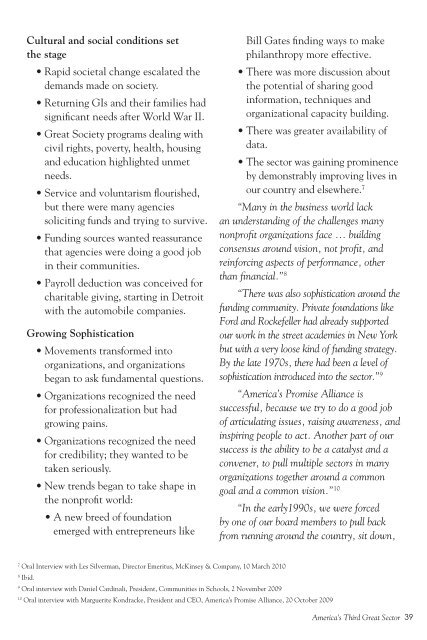Eunice Kennedy Shriver - The Human Spirit Initiative
Eunice Kennedy Shriver - The Human Spirit Initiative
Eunice Kennedy Shriver - The Human Spirit Initiative
Create successful ePaper yourself
Turn your PDF publications into a flip-book with our unique Google optimized e-Paper software.
Cultural and social conditions set<br />
the stage<br />
• Rapid societal change escalated the<br />
demands made on society.<br />
• Returning GIs and their families had<br />
significant needs after World War II.<br />
• Great Society programs dealing with<br />
civil rights, poverty, health, housing<br />
and education highlighted unmet<br />
needs.<br />
• Service and voluntarism flourished,<br />
but there were many agencies<br />
soliciting funds and trying to survive.<br />
• Funding sources wanted reassurance<br />
that agencies were doing a good job<br />
in their communities.<br />
• Payroll deduction was conceived for<br />
charitable giving, starting in Detroit<br />
with the automobile companies.<br />
Growing Sophistication<br />
• Movements transformed into<br />
organizations, and organizations<br />
began to ask fundamental questions.<br />
• Organizations recognized the need<br />
for professionalization but had<br />
growing pains.<br />
• Organizations recognized the need<br />
for credibility; they wanted to be<br />
taken seriously.<br />
• New trends began to take shape in<br />
the nonprofit world:<br />
• A new breed of foundation<br />
emerged with entrepreneurs like<br />
7 Oral Interview with Les Silverman, Director Emeritus, McKinsey & Company, 10 March 2010<br />
8 Ibid.<br />
9 Oral interview with Daniel Cardinali, President, Communities in Schools, 2 November 2009<br />
Bill Gates finding ways to make<br />
philanthropy more effective.<br />
• <strong>The</strong>re was more discussion about<br />
the potential of sharing good<br />
information, techniques and<br />
organizational capacity building.<br />
• <strong>The</strong>re was greater availability of<br />
data.<br />
<strong>The</strong> sector was gaining prominence<br />
by demonstrably improving lives in<br />
our country and elsewhere. 7<br />
•<br />
“Many in the business world lack<br />
an understanding of the challenges many<br />
nonprofit organizations face … building<br />
consensus around vision, not profit, and<br />
reinforcing aspects of performance, other<br />
than financial.” 8<br />
“<strong>The</strong>re was also sophistication around the<br />
funding community. Private foundations like<br />
Ford and Rockefeller had already supported<br />
our work in the street academies in New York<br />
but with a very loose kind of funding strategy.<br />
By the late 1970s, there had been a level of<br />
sophistication introduced into the sector.” 9<br />
“America’s Promise Alliance is<br />
successful, because we try to do a good job<br />
of articulating issues, raising awareness, and<br />
inspiring people to act. Another part of our<br />
success is the ability to be a catalyst and a<br />
convener, to pull multiple sectors in many<br />
organizations together around a common<br />
goal and a common vision.” 10<br />
“In the early1990s, we were forced<br />
by one of our board members to pull back<br />
from running around the country, sit down,<br />
10 Oral interview with Marguerite Kondracke, President and CEO, America’s Promise Alliance, 20 October 2009<br />
America’s Third Great Sector<br />
9




